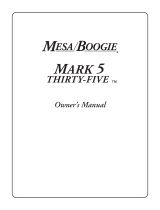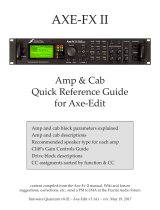
REAR PANEL: (continued)
FX LOOP: SEND / RETURN: These two 1/4" jacks are the patch point for external effects. The Effects Loop is wired in
parallel with the normal signal. Connect the Send jack of the STUDIO CAL to your
Effects Input jack. Connect the Return jack of the STUDIO CAL to the Output jack of
your effect unit. The Effects Loop is a patch point between the pre-amp and power section,
therefore the Return jack can double as a "Power Amp Input" jack. When the Return is
used as an input, the Presence control of the active channel and the Output Level control
are being utilized, all other controls are inactive.
FUSE
1.25A
2.5A SB RECORDING
FTSW REV RETURN
SEND
PAGE 7
FX MIX: This control determines the dry/wet blend of the FX Loop signal in relation to the unaffected signal. Set to 0% you will
experience only the dry signal (no effect) and at a setting of 100% the entire
signal will be wet (total effect.) For the best results...Set the mix of your effect
to 100% wet. Then dial in the amount of effect that you wish to hear, starting
at 0% with the FX Loop Mix Control. The drier (closer to 0%) signal you use,
the better your tone should be. This parallel type FX Loop allows the amplifier
to retain its purity with the smallest amount of degradation possible due to
possible effect impedance mismatching.
FUSE
FX MIX
0% 100%
RECORDING
FTSW REV RETURN
SEND
1/2 A
1/4
1A
This 1/4" jack and control provide a signal derived from the speaker jack. Perfect for using the STUDIO CALIBER
as a master pre-amp, or additional power amps may be connected for more power when needed.
Some players use this to derive an FX Send Signal and go to other amps for their wet sound.
NOTE: Once a signal is taken from the Slave, it can not be inserted back into the FX Loop Return
jack or a feedback loop will occur. Much like holding a microphone into the PA system’s cabinets...a
loud high pitched squeal will occur.
SLAVE:
SLAVE
SILENT RECORDING: This rocker switch which is located down under the chassis and selects between the live "Speaker
On" setting and the silent "Speaker Mute" setting. This is a
perfect solution for all-nighters! This switch mutes all of the
signal at the power section driver stage, removing the need
for a speaker load IN THIS POSITION ONLY!
NOTE: When this switch is set to the "ON" position, a
speaker load must be maintained by either a load
resistor of some type or a speaker itself. Failure to
comply with this instruction could result in major damage to
the amplifier. Leave your speaker connected.
SILENT RECORDING
MUTE SPKR ON
FUSE
FX MIX
0% 100%
RECORDING
FTSW REV RETURN
SEND
1/2 A
1/4
1A
SPEAKERS: Sensitivity to speaker mismatching in regards to ohmage differences is low, hence no damage to the amplifier
will occur. However, very low ohmage loads will cause the power tubes to wear faster. When using
two 8-ohm speakers, connect them both to the 4-ohm outputs provided (this will equal a 4 ohm load.)
8 OHM 4 OHM 4 OHM
SPEAKERS

















